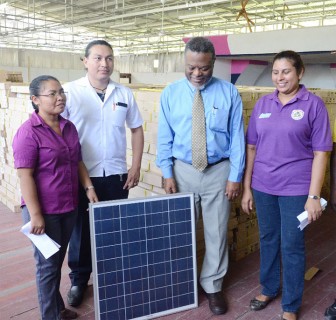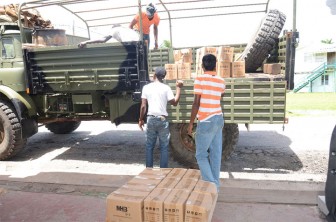A second batch of solar panels for the government’s hinterland electrification programme is expected to be delivered today.
According to Project Accountant Annie Ramnarain, some 10,000 units are expected to be delivered and installed by the end of April. She explained that already 1,000 solar panels were distributed last year, while the remaining 10,000 are expected to complete the process this year.

“Under this project, there’s 11,000 solar panels inclusive of the accessories; the wire, clips, pockets and bulbs and all that. We’ve started across Region 9; over the weekend we delivered 888 systems and today [Wednesday] we are going to start roughly around 500. Today and tomorrow we are going to load the trucks and tomorrow night we are going off,” she said adding that residents in all 54 villages in Region 9 will be receiving solar systems.
Over the weekend, she said, Apoteri (22), Rewa (48), Crash Water (36), Annai (80) Aranaputa (98) Fair View (55), Surama (52), Rupertee (61), Yakarinta (93), Massara (52), Kwatamarang (71), Kwamatta (30), Toka (45) received panels, bringing the grand total to 888.
Villages expected to receive this batch include Fly Hill (32), Kaicumbay (30), Quatata (46), Parashara (32), Nappi (79), Quarine (36), Moco Moco (87) and Semoni (32).
Ramnarain said that each panel was of 12 volts and will be able to power about two bulbs.

However, Prime Minister Samuel Hinds explained that because they were 65-watt solar panels, in a month, one unit will be able to obtain about 12-15 kilowatts hours of electricity which would be enough to supply lighting to a number of low energy lamps in addition to a small radio or a similar electronic appliance.
“This is an electrification project through which we are working to ensure that every family, every home in Guyana has some degree of electrification and we have this programme for the hinterland area,” he said.
The Prime Minister noted that in September last, two persons from each village were trained by Ministry of Amerindian Affairs personnel and these individuals will serve as the primary installers in their respective villages. He further stated that with two assistants each, they will be given knowledge on how operate and repair the units.
In addition to this, a Hinterland Electrification Unit was formed and it is expected that members will visit the villages twice a year to check the condition of the panels.
Also, the Community Developmental Officers have been involved in the installation, training and supervision phase. For sustainability, each applicant is asked to make a contribution of $500 a month to ensure that there will be a fund for the replacement of lamps, batteries, lights and so on. These payment programmes are said to have been already worked out so as to ensure sustainability.
With regard to the delay of the programme, Hinds said that the Danish group which had won the contract contributed to the delay by sourcing equipment from China.
“There were some bits of delay based on the issue of delivery and I think most times when you are taking things out of the US, it’s a week away but from China its 6 to 7 weeks so that created an extra delay,” he said.
Also, the PM stated, some difficulty was also experienced with the auxiliary equipment. “There were some challenges on some awards of contracts…. The group that was initially awarded the contract, the other contested it.
That matter is still being worked out but that created another set of delays,” he noted.
Meanwhile, Project Coordinator Sharon Austin stated that the MoAA has contributed by assisting in putting together logistics and coming up with the cost.
“We are working towards the development in Amerindian communities and this is a priority. We are expecting that with this investment, the hinterland students can be able to use the energy and lighting facilities to study and advance in their educational pursuits and we look forward to completion of the project and development of the Amerindian communities as well,” she said.
The government had been hoping that this project would be financed by monies coming under the forestry protection deal with Norway. However, Guyana has not been able to present a comprehensive case yet to permit disbursement of funds for the project. As a result, the government went ahead and used its own resources.
In July last year, former President Bharrat Jagdeo had said that within two to three months, solar panels would be given to each home in every Amerindian community. Jagdeo had lashed out at the World Bank – the trustee for the Guyana REDD+ Investment Fund (GRIF) – for sloth in disbursing funds. The GRIF is a fund for the financing of activities identified under the Guyana’s Low Carbon Development Strategy (LCDS).
He recalled that US$8 million had been identified for the Amerindian community for solar panels. There was an international tender for the solar panels and a Danish company won the bid. “But we can’t get them to pay for this because guess what, they want to come to your communities and ask you whether you want these solar panels or not; whether it will create environmental problems or social problems…,” the President said in an apparent reference to the World Bank. “All of these safeguards. It’s a straightforward procurement…,” he continued.
“So what we’ve done, we’re taking US$3 million from our own budget and buying the solar panels,” he said to loud applause.





